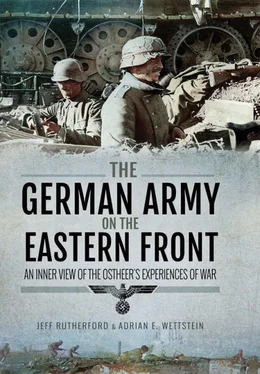The battalion was equipped in a way that has not been seen in the East either with our own or with other units. Armament: purely MG 42, namely for each company 12 light and 2 heavy machine guns. In addition, in each company two medium mortars. Combat strength of the companies average 130 men. The equipment for the winter, from the complete winter clothing, to sleds, rescue toboggans, skis up to and including coal for heating was described as perfect.
A training of the battalion with the assigned weapons has almost not taken place at all. During the time of the use on the coast, only training on the immobile defensive weapons was carried out. Only in the reserve company was some terrain training carried out. After the formation of the battalion, a special training on the heavy machine gun and mortar was begun, which however had to be interrupted after five days as a result of transport to the east. Use, handling and maintenance of all weapons, priming and use of hand grenades, and the use of the spade invariably are almost unknown to the battalion. The principles on the use of weapons and the building of positions are also unknown to most officers and NCOs.
During the formation of the battalion, it never trained as a unit at all. Therefore, none of the leaders were trained in smooth cooperation. Because of their short affiliation with the troops, most of them hardly knew each other.
The personnel situation was as follows:
NCOs and men at march out: 800
Thereof with experiences in the East: 8% 60
Thereof with otherwise war experiences (France) 90
Without any war experience 81% 650
Officer situation at march out: 11
of which with experience in the East (mainly partisan war) 5
of which otherwise war-experienced (campaign in France) 3
of which without war experience: 3
A 46-year-old Hautpmann was appointed as the leader of the battalion, who until now had been company commander of a bicycle company, and so far had occasionally led a battalion as deputy. He had experience in bandit warfare, but all that is fundamental in the entrenchment and defence of a position is completely new to him. A Leutnant was assigned to him as adjutant, who learned about and took over the affairs of the adjutant for the first time at the end of October 1943. His wartime experiences were limited to the war against France. He had not been in the East yet. The same information applies to the special mission staff officer. Of the company leaders two had experiences in the East. However, the experience of the one limited itself to the staff activity. The third company leader was 2 months [in the Soviet Union], and the fourth not yet in the East.
Immediately prior to the start of the railroad transport, the battalion was given replacements from the class of 1925, which accounted for 16% of the total strength. These young men were all grouped together in a company. As a result of imperfect training and inexperience among the leaders and NCOs, these young replacements suffered considerable casualties within a few days, so that now only 9% are still available.
The total losses of the battalion were also comparatively high as measured by combat activity. Within 9 days, there were 180 casualties. These losses are mainly attributed to the lack of combat experience, likewise the comparatively high losses of armament, devices and equipment already in the first 24 hours.
Such a wear-and-tear of people and material would not have occurred in a veteran unit. There, men as well as weapons and equipment come into expert hands. What is lacking in training will be made good in a sound form, be it during the deployment, and weapons are issued only to those people who could operate them.
It seems more appropriate to refrain from such new formations, and to correspondingly replenish the old, combat-proven companies. Only then can such losses be avoided. We cannot afford any superfluous losses in the currently strained replacement situation.
It should also be borne in mind that there is a tradition in the old front regiments and thus the feeling of pride in one’s own troop. These are the things which, even in difficult situations, enable the troops to achieve a particularly high fighting performance.
Obviously, these conditions are completely absent in the case of such a loosely composed units as in these new formations. As a result, the fighting spirit of such a force is far less. For this reason too, such a preferred equipping [of the unit] appears to be completely out of place.
Panzer Grenadier Regiment 13 also reports that from 22.–24.11.1943, another battalion was attached to it. Here the conditions were the same as in the case of the I./894. After a deployment of 48 hours, the battalion commander reported that he had only around 250 out of 800 men still in hand! This, too, was not a result of the fighting situation, but merely the effect of the inexperience of the troops and their leaders. The troop itself is the least to blame. It is not responsible for its inexperience, and it must also be acknowledged that the good will is undoubtedly present. This good will, however, can neither replace the lack of training nor the complete inexperience of command and troops.
Once again, the source indicates that manpower deficiencies were not as damaging to the unit as was the lack of men – and especially commanders – familiar with conditions and combat in the east. In this particular case, material questions were not an issue. This source thereby reflects a larger problem that occasioned many complaints in the second half of the war, namely the uneven distribution of new equipment. Many newly formed units received new weapons and equipment while older units had difficulties in acquiring either replacements for lost or destroyed material or newly introduced weapons. This process further weakened older units. An issue not even talked about is the amalgamation of a unit trained as an infantry formation into a tank unit, despite the fact that many of these men had never before seen the inside of a tank. This was certainly a contributing factor to the decline of German Panzer units’ combat power in the second half of the war, and is a topic which deserves more research.
Even after the forwarding of replacements and transfers of full units to the east, German manpower in the Soviet Union always operated in a shortage – and it was a shortage that only worsened as the war continued. In an attempt to overcome this scarcity, the German army started to draw manpower from new sources. The most obvious means, yet often overlooked, was to shift men within the army apparatus. A well-known example of this was the tasking of Generalleutnant , later General der Infanterie , Walter von Unruh, with combing through all agencies and rear units for men to be sent to the front. Beginning in late 1942, his competencies were expanded to federal departments and Nazi party institutions. His success in creating large numbers of soldiers was moderate, but it nonetheless led to conflicts with Armaments Minister Albert Speer, because each drew from the same pool. More important was the shifting within the field army’s frontline troops, as the following order from the OKH on the enhancement of the combat power in autumn 1942 shows: [17]
Prior to spring 1943, one cannot expect any significant replacements arriving. We must resign ourselves to this fact, and do everything we can to maintain and increase our combat strength.
Therefore the following measures must be carried out as soon as possible:
1) Complete disbanding of individual units and formations, disbanding and reduction of baggage trains;
2) Replacement of the German soldier by Russian Hilfswillige (prisoners of war) in such places which do not need to be occupied by combat soldiers. In many units this has already been carried out to a large extent, although further measures are still necessary.
Читать дальше






![John Stieber - Against the Odds - Survival on the Russian Front 1944-1945 [2nd Edition]](/books/405234/john-stieber-against-the-odds-survival-on-the-russian-front-1944-1945-2nd-edition-thumb.webp)





